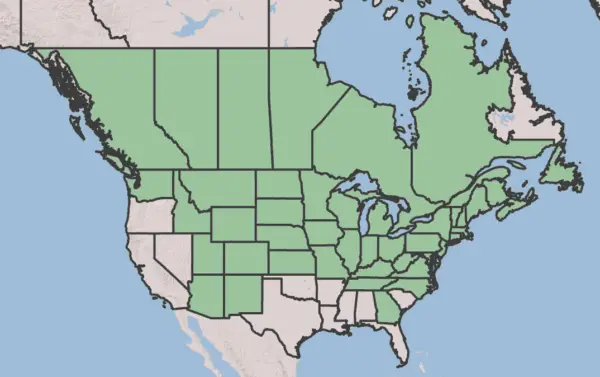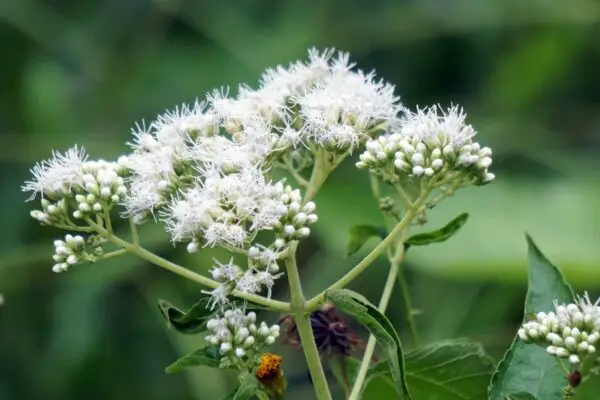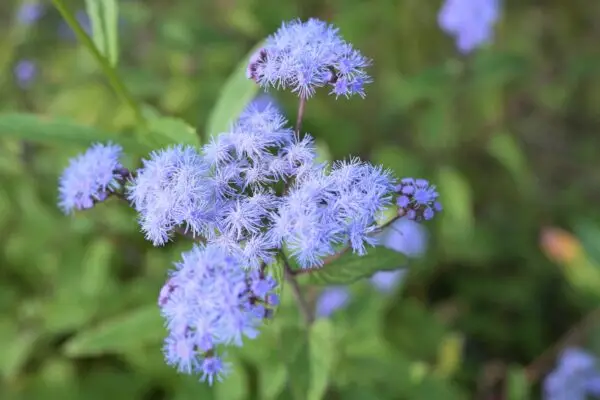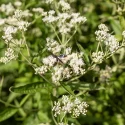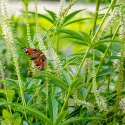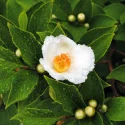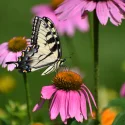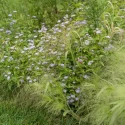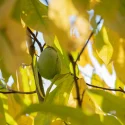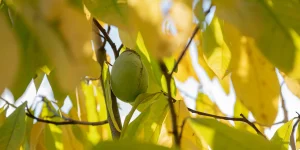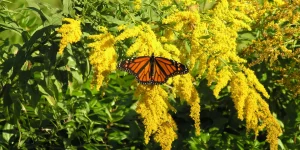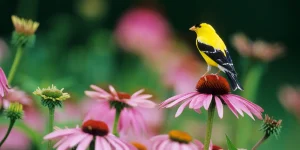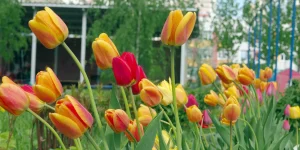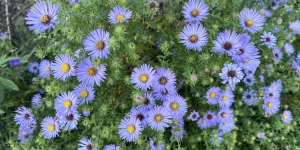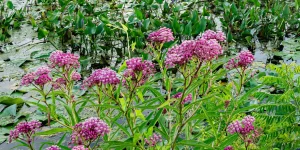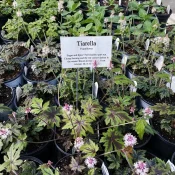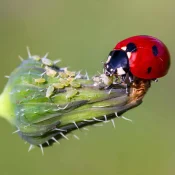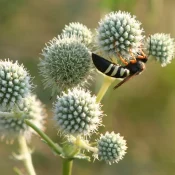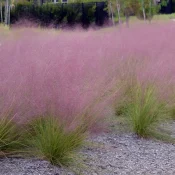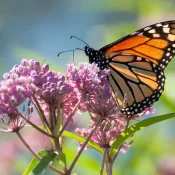Joe Pye Weed
These tall, late-blooming native plants offer crucial pollen and nectar towards the end of the summer season when many other flowers are wrapping up their bloom time. Joe Pye Weed has one of the most confusing common names for a plant—who is Joe Pye, and why would I want to plant a weed? But once you meet Joe Pye and his namesake flower, you will want to plant at least half a dozen in your sunny garden. Bonus: they are super drought-tolerant. Scroll on to meet Joe Pye—both the plant, and the man.
- Full Sun, Part Sun
- Tall (5'+)
- Summer flowers
- Host Plant
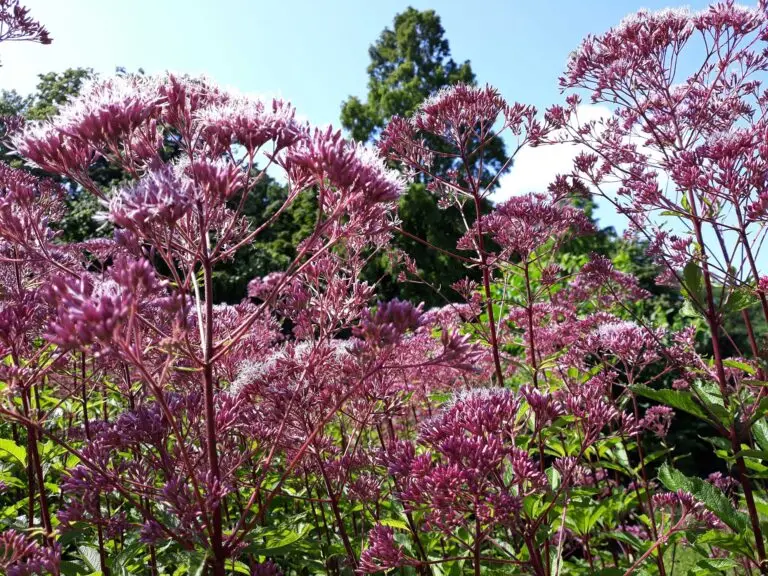
Why plant Joe Pye Weed?
Here’s what makes it so special:
It feeds pollinators. Joe Pye Weed blooms in late summer, offering essential nectar to bees and butterflies when many other flowers have faded.
It’s low-maintenance. Once established, it thrives on rainfall alone—no fertilizers, no fuss. It’s a lush, tall stunner that doesn’t ask for much. Since it’s a perennial, it comes back year after year.
It belongs here. As a North American native, Joe Pye Weed has thousands of years of experience surviving droughts, cold snaps, and weather extremes. It’s built to last—and to support the bugs, birds, and butterflies that belong here too.
It’s gorgeous. Towering blooms in soft purples and pinks prove you don’t have to sacrifice beauty for sustainability.
Now that we’ve given reasons why to plant Joe Pye Weed, let’s get right to the big question:
Who is Joe Pye?
Joe Pye Weed is a strange common name. (A common name is a plant name given by the generations before us. While there is always only one Latin name, a plant can have many common names.) Very few native plants have common names based on people.
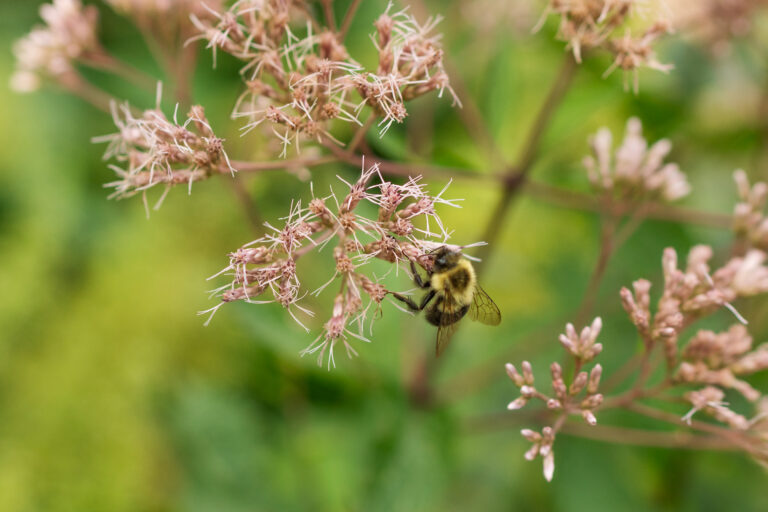
Botany books over the centuries have described Joe Pye as “an Indian herbalist” or a “wandering medicine man” who lived somewhere on the eastern seaboard in the 1600s. The location in these stories varies from Maine to South Carolina.
Meet the real Joe Pye
The real Joe Pye may have been identified as recently as 2017. According to a 24-page, thoroughly researched, peer-reviewed paper in the University of Michigan’s Great Lakes Botanist:
“Discrepancies have long existed as to the race of the man for whom Joe-Pye-weed was named, the century and the part of the country in which he lived, and even whether the plant name was derived from the name of any person, real or fictional. Our investigation has indicated that this plant name is from the cognomen of Joseph Shauquethqueat, an 18th- and early 19th-century Mohican sachem, who lived successively in the Mohican communities at Stockbridge, Massachusetts, and New Stockbridge, New York.” (Source)
Joseph Shauquethqueat—or Joe Pye—needs a Hollywood movie
His story is an epic American narrative—complete with war, betrayal, migration, and a cameo from George Washington.
(We’ll give you the short version here—then I promise we’ll get back to planting tips.)
Let’s meet Joe.
Joseph Shauquethqueat was born in 1722 into the Mohican community. “Pye” was a colonist shorthand for Shauquethqueat—a common early American practice, as many Mohicans were given or adopted Anglicized surnames when signing official documents.
As a young man, he and his community were displaced from their homelands in what’s now Albany, New York, and relocated to Stockbridge, Massachusetts. The move was framed as a “reward” for the Mohicans’ alliance with British colonists during the French and Indian War.
The Stockbridge land gift was a sham. White settlers quickly encroached on the land. Racist laws made it nearly impossible for the Mohicans to protect their property or even own businesses.
Joe becomes Chief Sachem
In 1777, Shauquethqueat became Chief Sachem of the Stockbridge Mohicans. During his time as leader, he asked the Massachusetts government to protect what they had been given: “[w]e and our fathers had once been the rightful possessor of all your Country,” he wrote in one letter.
The letters didn’t matter. “In 1785, the Stockbridge Mohicans, impoverished and having succumbed to pressures to sell much of their land in Massachusetts or surrender it in settlement of debts, and with their civil rights in Stockbridge being eroded as the white population increased, began an exodus to what is now part of Madison and Oneida counties, New York.”
Shauquethqueat didn’t trust the government for this second move.
The Oneida, another Indigenous nation, offered the land.
Enter George Washington—yes, that George Washington
Picking up and moving an entire community is a miracle, especially one with a target on its back. Shauquethqueat needed protection.
On July 2, 1783, Shauquethqueat wrote to a white leader asking for protection: George Washington. Washington wrote back that the Mohicans had “remained firmly attached to us, [and had] fought and bled by our side…consider them as friends and subjects to the United States of America.”
The letter helped deliver safe passage to New York—a tiny bit of light against generations of violence and disenfranchisement.
So, how did the plant get named for ‘Joe Pye’?
The Joe Pye Weed plant is known within Indigenous communities for helping ease fevers. It became a medicine that European colonists depended on. Stories tell of Native Americans saving white settlers from death by introducing its medicinal properties.
This medicinal plant needed a memorable and trustworthy name.
The name Joe Pye Weed came from European settlers, who used a name they knew and respected for a plant they depended on.
Plant for beauty and to honor Joseph Shauquethqueat’s legacy
Plant Joe Pye Weed to honor this great man’s valor, vision, and leadership alongside Native Americans’ incredible knowledge of our living world. (Read about Pawpaw trees and Boneset for other movie-worthy plant name backstories.)
Now that we know the story, let’s get into how to grow it in your yard.
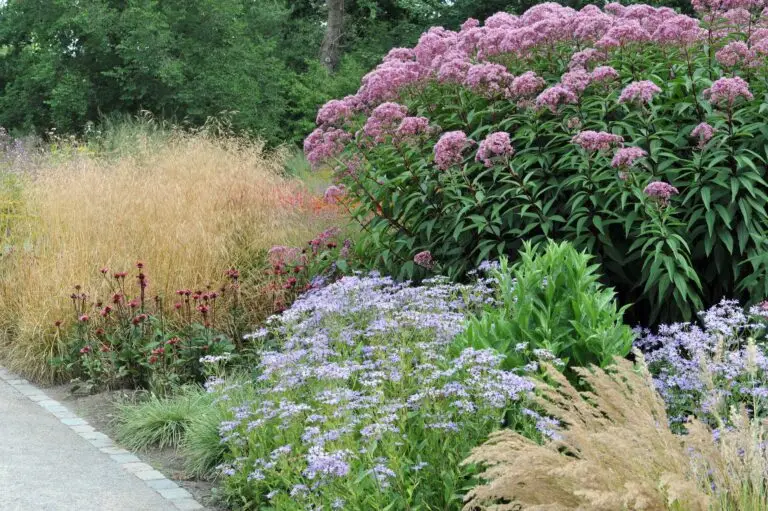
How to grow Joe Pye Weed
Joe Pye Weed is one of the easiest native flowers to grow. They thrive in:
- Full sun to partial sun. They can handle blazing sunshine, and also be fine on the edges of tree lines.
- It prefers consistently moist spots, but it can also happily grow in more dry areas.
There are several species of Joe Pye Weed
Joe Pye Weed is the common name for several species of plants within the Eupatorium genus. Each plant has pink-purple blooms and is a butterfly favorite. The main difference between species is seen in their height:
- Hollow Joe Pye Weed (Eupatorium fistulosum) can get up to 10 FEET
- Sweetscented Joe Pye Weed (Eutrochium purpureum) and Spotted Joe Pye Weed (Eutrochium maculatum) are 6 feet tall
- Coastal Plain Joe Pye Weed (Eutrochium dubium) is the shortest at 4 feet
- There are also some cultivars (one is called ‘Baby Joe’) that are even shorter. We recommend planting true native plants over cultivars, when possible.
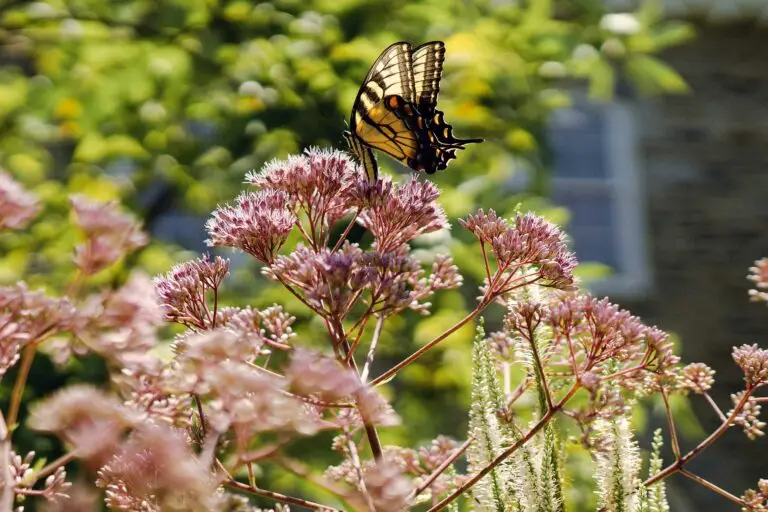
Plant Joe Pye Weed from seed
It’s easy to grow Joe Pye Weed from seed. Plant by seed in the spring and enjoy flowers in the fall. After the first year, plants will continue to grow in nearby space. If they get too large or too numerous, dig up and divide them in the spring or fall. (Prairie Nursery offers both plants and seeds for Spotted Joe Pye Weed.)
Where to plant Joe Pye Weed
Most Joe Pye Weed species are tall: 3-10 feet. Plant it in the back of a garden, surrounded by medium and short-height native plants. One of the amazing things about this plant is that it does not require staking!
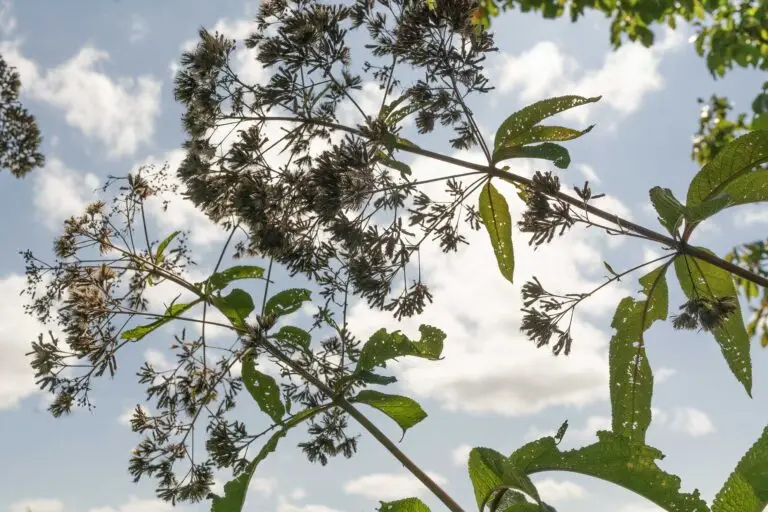
All species of Joe Pye Weed are host plants
All species of Joe Pye Weed are host plants for more than 35+ species of moth and butterfly caterpillars, including Ruby Tiger Moths and Clymene Moths.
What is a host plant?
A host plant is a specific plant that a bug, butterfly, or caterpillar eats, lives on, or lays its eggs on.
You may be looking at Joe Pye Weed and thinking…it looks similar to another plant. And you’re right! There are a few native plants that look similar to Joe Pye Weed:
Native flowers similar to Joe Pye Weed
There are a few other natives that look similar to Joe Pye Weed, with different coloring and heights:
What to Plant with Joe Pye Weed
These plants are fantastic pairings. They offer flowers at different parts of the growing season so pollinators have lots of food and shelter.
Joe Pye Weed’s name comes with a biography worth retelling for generations, and its value to pollinators cannot be denied. Plant a few in your garden alongside flowering native plants that bloom at other parts of the season for a truly stunning pollinator garden. Make sure to add a nametag and share the history with neighbors when they ask, “Who is Joe Pye?” Keep learning about other native plants with incredible backstories by visiting our guide to Boneset, Coneflowers (aka Echinacea), or Magnolias. Or, keep exploring host plants and visit our Best Native Host Plants round-up. Happy planting!
Sources
- Pearce, Richard and Pringle, James. Joe Pye Weed: The History and Eponymy of the Common Name. The Great Lakes Botanist, 2017.
- The New York Times, How Joe Pye Gave His Name to a Weed. Joan Lee Faust,
- Johnson, Lorraine. 100 Easy-to-Grow Native Plants for American Gardens in Temperate Zones. (1999), 104.
- USDA Plant Database, Joe Pye Weed
- Missouri Botanical Garden, Joe Pye Weed
- Minnesota Board of Water and Soil Resources, Joe Pye Weed. PDF, 2017.
- Minnesota Wildflowers, Joe Pye Weed.
